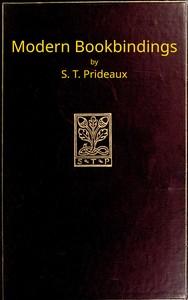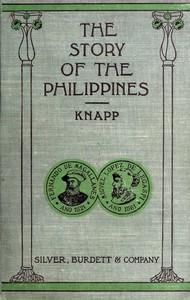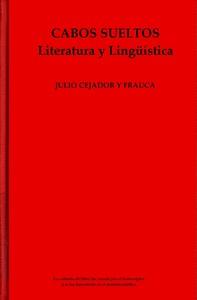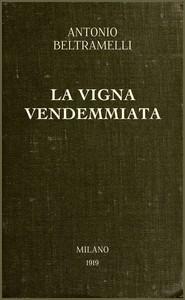|
|
Read this ebook for free! No credit card needed, absolutely nothing to pay.Words: 18670 in 4 pages
This is an ebook sharing website. You can read the uploaded ebooks for free here. No credit cards needed, nothing to pay. If you want to own a digital copy of the ebook, or want to read offline with your favorite ebook-reader, then you can choose to buy and download the ebook.

: Modern bookbindings: Their design and decoration by Prideaux S T Sarah Treverbian - Bookbinding@FreeBooksThu 08 Jun, 2023 iddle Ages as the goal towards which to strive. It was a time, he considered, when the processes or means by which life is lived constituted the end of life itself, without seeking for some other end external to them and often incompatible with them. This idea of 'art being the highest function of life' was the gospel to which he never ceased to direct the attention of his followers, and the next step--the attempted re-organization of life into conditions that enable art to realize itself--thus followed as a matter of course. As a protest against the mechanical exploitation of the arts for the sake of commercial success in its worst sense, and with the attendant evils of excessive competition, such a creed is most valuable, and has already had an important effect on the decorative arts which we trust may be permanent. But it would seem mistaken in theory and impossible of practice to attempt a reversion to mediaeval ideals with the wholly altered conditions of production, distribution and mode of living that are now part and parcel of modern life. A crusade against the existing conditions in which works of art are produced must, one would think, if its criticism is to be operative, find some way of including in its scheme of regeneration the great movements of commercial life which is one of the features of the age, and which even the most optimistic could hardly hope to stem. Here and there an individual may achieve a career somewhat in accordance with mediaeval ways, content with the limitations imposed by this ideal; but except in such isolated instances it does not seem possible to return to the practice of the past, when, as Mr. Lethaby says, 'the designer of a gold cup made it and sold it over the counter, and the art was thrown in like a Christmas almanack.' Here comes in the problem mentioned in a previous chapter. If, on the one hand, there is too much tendency for the designer to be occupied only in planning ornament for others to execute with the result that a certain inevitableness is nearly always wanting in the finished product, yet it may be better for a skilled workman to carry out the views of an artist rather than try and evolve variants from a few types set before him. In the frequent advocacy of a revival of past conditions which would benefit the workman, there is one point that seems always left unnoticed--a point of great importance; and that is the stringent means taken in those days to protect the purchaser also. In the scholarly little introduction called 'Art in the Netherlands' which Mr. W. H. James Weale contributed to the Catalogue of the picture exhibition held at Bruges in 1902, he gives a concise account of the conditions under which alone a man could become a painter in the fourteenth and fifteenth centuries; and what held good for painting held good also for the minor arts of life. As long as the craftsman belonged to the guild of his craft, he was bound by its rules to carry out his work honestly and conscientiously, to use good materials, and to beautify it as far as he was able. The corporation arranged for the education of its members. They were apprenticed to masters responsible both for their technical efficiency and the fulfilment of their duties of citizenship. Each was bound to the other; the apprentice was to give zeal in his service and the master to impart all he knew of his trade. Once the apprenticeship at an end, the youth could work, as what would now be known as an 'improver,' with any master he liked, and in any town that he chose. Later on, in order to become a master, he had to present himself before the heads of the guild and give proofs of efficiency, promise obedience to the rules of the corporation, and swear to carry on his work well and honestly. Observe, however, that, although a master, he remained all his life under the control of the governing body of the corporation, the members of which could enter his shop at any moment, seize his materials if of inferior quality, confiscate them, and inflict punishment upon him. Lastly, in disputes between himself and his clients the guild was called in to decide between them. We can imagine no condition less in touch with the schemes of modern and social democracy, which so often deal exclusively with the needs of the worker and neglect those both of the employer and the consumer. In connexion with this topic, mention should be made of Mr. C. R. Ashbee's experiment with the Guild and School of Handicraft. It began its existence at Essex House in East London, and, after fourteen years, in May 1902, removed to Chipping Campden, a small Cotswold village where the wool trade flourished during the Middle Ages and the silk trade in the eighteenth century. The aim of the Guild is set forth in a little pamphlet, distributed to visitors at the Dering Yard Gallery, 67A New Bond Street, where the work of the school is annually exhibited. It need only be said here that its object is to set a higher standard of craftsmanship by liberating the workman from the restrictions of the trade shop, and directing his independence away from purely individualistic efforts on to lines of art service to the community, and that it is conducted co-operatively, the men having an interest and a share in the concern and its government. While recognizing the importance of what a man does and the conditions under which he does it, both to himself as a citizen and to the community for which he labours, the Guild endeavours to strike a mean between the socialism that cares only for the worker and the commercialism that disregards him and his idealistic as well as material needs. The work carried out at Chipping Campden is very various, and includes furniture, metal work, jewellery, printing and binding. After Mr. Morris's death, Mr. Ashbee acquired the plant hitherto in use at the Kelmscott Press, and began a series of books, first in a Caxton type and later from a fount of his own design. Binding followed almost as a matter of course on these issues from the Essex House Press; and in connexion with it, besides the ordinary plain-tooled leather bindings, excellent in restrained ornament, he has revived certain fifteenth-century styles for which he has a special predilection, and which include the use of enamels and wooden boards, the latter often carved in low relief. The bindings, though designed for the most part by Mr. Ashbee, are carried out by Miss Power, who is in the main responsible for them. These books raise again the question whether such deviations from the ordinary paths are legitimate attempts to enlarge the limitations of the binder's art. The ultimate serviceable use of a book should ever be kept in sight, and must in the end determine the matter. Leather and vellum, tooled with a few fine stamps, disposed with taste and restraint, will always remain the best coverings for books, because they are unobtrusive and can be pleasantly handled and easily disposed. Work that is embossed, enamelled, carved, or even too decorative in colour for unlimited production, can only be desired as occasional specimens of interest in themselves, and as exceptions proving the rule. Mr. Douglas Cockerell, a pupil of Mr. Cobden-Sanderson, has written the first of a new series of technical handbooks on the artistic crafts which is a model of the kind and should prove the text-book for all future binders. It is, no doubt, the outcome of some years' teaching at the County Council School in Regent Street, where, for many years, he did excellent work in training the younger men to an intelligent interest in the various processes of their craft. No craft can be well learned anywhere but in a practical workshop; and he considers the value of class teaching to be limited to helping those engaged in a trade, and that such help is of great value in giving higher ideals and encouraging experimental work. From the beginning Mr. Cockerell has been specially interested in the repairing of books and in the preservation of old covers, and has given his pupils some training in all that relates to the care of books. There are numbers of old bindings that after four hundred years of wear and tear are still capable of fulfilling their original purpose of protection, with a little help from modern hands. To give a new lease of life to fine old books is really of far greater importance than the continual production of new and pretty bindings. Mr. Cockerell's original work is well known both here and in America, and there is luckily a great deal of it that is simple as well as highly decorated. It is comparatively easy to do the latter; but a plain binding that yet has the stamp of the maker's individuality is a very exceptional achievement, and in work of that character Mr. Cockerell is unsurpassed. Mr. F. Sangorski and Mr. G. Sutcliffe, who were formerly with Mr. Cockerell, have started a bindery of their own, and are engaged both in teaching and doing varied work of a pleasant character. Trained in the methods of Mr. Cockerell at the Technical School at 316 Regent Street, Mr. Sutcliffe now controls the teaching for the County Council at its branch establishment in Camberwell, and Mr. Sangorski that of the Northampton Institute in Clerkenwell. Mr. de Sauty is another young binder, and his work is of considerable merit. His inlays are distinguished for the taste shown in the association of colours, and his finishing has some of the brilliant qualities of the French school, seen particularly in the finely studded tooling of which he seems particularly fond. He has now the post formerly held by Mr. Cockerell. In concluding this sketch of Bookbinding in England as it appears to-day, we must not omit to speak of the entrance recently effected by women in many of the handicrafts, and notably in the one under consideration. Quite a number are now trying to make a livelihood out of bookbinding; and possibly, therefore, a few words less of criticism than of counsel may not come amiss. It may be said that there are certain conditions absolutely necessary for successful achievement, quite apart from financial gain, which is another matter. The first of these is a workshop training, which, though impossible some years ago, is now no longer so within certain limits; that is to say, there are one or two binders with small workshops who undertake to give women systematic teaching for a limited time. In a workshop they will see a variety of work that they will miss if taught privately, and they will learn the habit of rapid and dexterous manipulation of tools and materials without which it is impossible to work quickly enough for a profitable return upon the outlay. A second most necessary qualification is that they should have the physique for standing and working at a bench during the hours of an ordinary working day. For binding is not like other less specialized crafts that can be taken up at odd hours and laid aside with equal facility, but needs concentration of mind as well as sureness of hand. A third element in the desirable equipment is a certain faculty of imagination controlled by right feeling or good taste, so that the results of workmanship have the note of individuality without eccentricity. In art as in life, personality is the one thing needful, and we may fairly look to women to show the realization of it that can hardly be expected from those working in the stereotyped grooves of production. In conclusion, it is necessary to keep in mind that binding is but one of the sub-crafts that contribute to the production of books. Of late each of these has pursued its own often faulty ideals regardless of its relationship to the other contributory crafts. The paper-maker, the printer and the binder would be more likely to work intelligently if they had some mutual knowledge of each other's needs and limitations. The habit has been growing for some time of looking on the binding of a book as the most important thing in connexion with it. But the binder of the future, if his work is to be an effective contribution to decorative art, must look on the book itself as the unit of interest, the thought, embodied in typography and illustration, constituting a whole to which in the decorated cover he adds, not an essential part, but as it were the crown or coping-stone. MODERN FRENCH BINDING I In the spring of 1902 there took place in Paris the first of the exhibitions to which the new Galliera Museum is henceforth to be devoted. This Gallery, still unknown to a considerable number of English visitors, was built by Ginain in the style of the French Renaissance, and is all that a small museum should be. Its history is briefly as follows. In 1878, the Duchesse de Galliera presented to the City of Paris a plot of ground situated in the Rue Pierre-Charron by the Trocadero avenue, and undertook to erect upon it a suitable building in which to house the collection of works of art that she proposed leaving to the nation. Before, however, it was finished, and in consequence of the political events that resulted in the expulsion of the heads of princely houses from France, the Duchess had made a will in which she left her pictures to her native town of Genoa, only making provision for the completion of the Gallery. She died in 1888, and soon afterwards Paris found herself in possession of this fine museum, surrounded with gardens, and admirably appointed in the architectural detail so well understood by the French, but empty of all the treasures it was to have housed. What was to become of it? The municipal council decided that it should be devoted to industrial art, forming a sort of supplement to the Carnavalet Museum, and the necessary furnishing was undertaken with a view to that end. It was formally opened in 1895, but for five years after that remained practically empty, though purchases were made from successive Salons of different kinds of decorative art and disposed among the vacant rooms to form a nucleus for future acquisitions. In 1900 the Council, after much deliberation, decided that the museum should be devoted to periodical industrial exhibitions, and the first one, of a miscellaneous character, took place in the following year. Its distinctive feature consisted in what was an entirely new departure for France, namely, that every craftsman signed his work instead of being represented only in the name of the firm which employed him. This idea, to which we have now long been accustomed through the efforts of the Arts and Crafts Society, was a very novel one for our neighbours, and is to be adopted henceforth in all the Galliera exhibitions. The initiative met with such undoubted success that the Germans proceeded at once to start a museum at Mulhouse on similar lines. The organizing jury of the Council, which includes the foremost men of letters, artists and critics, next decided that the yearly exhibitions should each be devoted to a special branch of decorative art. The first of these was inaugurated in May 1892, in an admirably planned show of modern bindings comprising the latest developments, and, it must be added, eccentricities of ornamental book covers. The number sent in necessitated the largest gallery being set aside for their reception, and was a testimony to the confidence felt by the binders that merit would be the sole criterion. And indeed, though much interesting work was rejected, not only were the well-known artists well represented, such as Michel, Mercier, Gruel, Ruban, Canape, Lortic, Carayon, etc., but room was found for the curious vellum covers of Pierre Roche and the incised and modelled leather of Lep?re with whom Michel and others so happily collaborate. The impression made upon the visitor was at once one of careful selection and admirable disposition. In contrast to the wretched instalment offered by the great Exhibition of 1900, the work of every binder was seen to the best advantage, the eye was not fatigued by too many show-cases, and the harmony of surroundings left nothing to be desired. The display of works of art is in itself a study, and we could undoubtedly learn much from the French in the excellent arrangement of their galleries. But what a strange transition from that great room in the Biblioth?que Nationale, where rest at last the classic specimens of work that may without exaggeration be included among the fine arts, to this most modern of collections! When in the Biblioth?que Nationale we are reminded of that exquisite sonnet of H?r?dia-- V?LIN DOR? Vieux ma?tre relieur, l'or que tu ciselas Au dos du livre et dans l'?paisseur de la tranche N'a plus, malgr? les fers pouss?s d'une main franche La rutilante ardeur de ses premiers ?clats. Free books android app tbrJar TBR JAR Read Free books online gutenberg More posts by @FreeBooks
: The swamp was upside down by Leinster Murray Freas Kelly Illustrator - Science fiction; Space colonies Fiction; Geology Fiction@FreeBooksThu 08 Jun, 2023

: The story of the Philippines for use in the schools of the Philippine Islands by Knapp Adeline - Philippines History@FreeBooksThu 08 Jun, 2023
|
Terms of Use Stock Market News! © gutenberg.org.in2025 All Rights reserved.






